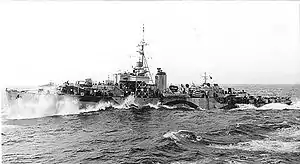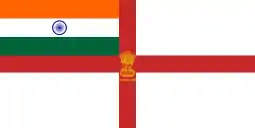River-class frigate
The River class was a class of 151 frigates launched between 1941 and 1944 for use as anti-submarine convoy escorts in the North Atlantic. The majority served with the Royal Navy (RN) and Royal Canadian Navy (RCN), with some serving in the other Allied navies: the Royal Australian Navy (RAN), the Free French Navy (FFN), the Royal Netherlands Navy and, post-war, the South African Navy (SAN).
 HMS Swale | |
| Class overview | |
|---|---|
| Operators: | |
| Succeeded by: | Loch class |
| Subclasses: | RN group I, RN group II, RAN group I, RAN group II, RCN group |
| In commission: | 1942 |
| Planned: | 30 |
| Completed: | 151 |
| Cancelled: | 2 |
| Active: |
|
| Lost: |
|
| Preserved: | 2 |
| General characteristics RN group I | |
| Displacement: |
|
| Length: | |
| Beam: | 36 ft 6 in (11.1 m) |
| Draught: | 9 ft (2.7 m); 13 ft (4.0 m) (deep load) |
| Propulsion: |
|
| Speed: |
|
| Range: | 7,200 nautical miles (13,300 km; 8,300 mi) at 12 knots (22 km/h; 14 mph) with;440 long tons (450 t; 490 short tons) oil fuel |
| Complement: | 107 |
| Armament: |
|
| General characteristics (RN group II) | |
| Range: | 646 long tons (656 t; 724 short tons) oil fuel; 7,500 nautical miles (13,890 km) at 15 knots (27.8 km/h) |
| Notes: | Other data per RN group I |
| General characteristics (RCN group) | |
| Displacement: |
|
| Range: | 646 long tons (656 t; 724 short tons) oil fuel; 7,500 nautical miles (13,890 km) at 15 knots (27.8 km/h) |
| Complement: | 157 |
| Armament: |
|
| Notes: | Other data per RN group I |
| General characteristics (RAN group I) | |
| Displacement: |
|
| Range: | 500 long tons (510 t; 560 short tons) oil fuel; 5,180 nautical miles (9,593 km) at 12 knots (22.2 km/h) |
| Complement: | 140 |
| Armament: |
|
| Notes: | Other data per RN group I |
| General characteristics (RAN group II) | |
| Displacement: |
|
| Complement: | 177 |
| Armament: |
|
| Notes: | Other data per RAN group I |
The first orders were placed by the Royal Navy in 1940, and the vessels were named for rivers in the United Kingdom, giving name to the class. In Canada, they were named for towns and cities, though they kept the same designation.[1] Originally called a "twin-screw corvette", the name "frigate" was suggested by Vice-Admiral Percy Nelles of the Royal Canadian Navy.[2] Canada originally ordered the construction of 33 frigates in October 1941.[1][2] The design was too big for the locks on the Lachine Canal so it was not built by the shipyards on the Great Lakes and therefore all the frigates built in Canada were built in dockyards along the West Coast or along the St. Lawrence River below Montreal.[2] In all, Canada ordered the construction of 70 frigates, including ten for the Royal Navy, which transferred two to the United States Navy.[1] Twelve were built in Australia for the RAN (four to a modified design).
After World War II, they found employment in many other navies the world over; several RCN ships were sunk as breakwaters. One, HMCS Stormont, was purchased by Aristotle Onassis and converted into the luxury yacht Christina O.
Design
.jpg.webp)
The River-class ships were designed by naval engineer William Reed, of Smith's Dock Company of South Bank-on-Tees, to have the endurance and anti-submarine capabilities of the Black Swan-class sloops, while being quick and cheap to build in civil dockyards using the machinery (e.g. reciprocating steam engines instead of turbines) and construction techniques pioneered in the building of the Flower-class corvettes. Its purpose was to improve on the convoy escort classes in service with the Royal Navy at the time, including the Flower class.
Improvements over the corvette design included improved accommodation which was markedly better. The twin engines gave only 3 knots (3 mph; 6 km/h) more speed, but extended the range of the ship to nearly double that of a corvette, to 7,200 nmi (8,286 mi; 13,334 km) at 12 knots (14 mph; 22 km/h).[2] Among other lessons applied to the design was armament better designed to combat U-boats, including a twin 4 in (102 mm) mount forward and 12-pounder (76 mm (3 in)) aft.[1] Fifteen Canadian frigates were initially fitted with a single 4 in (102 mm) gun forward, but with the exception of HMCS Valleyfield, they were all eventually upgraded to the twin mount.[2] For underwater targets, it was equipped with a Hedgehog anti-submarine mortar with depth charge rails and four side-mounted throwers aft for a 10-charge pattern (some had 8 throwers for a 14-charge pattern for a brief period until this was abandoned).[1]
River-class frigates were the first Royal Canadian Navy warships to carry the 147B Sword horizontal fan-beam active sonar transmitter, in addition to the regular ASDIC. This allowed the ship to maintain contact with targets even while firing, unless a target was struck. Improved radar and radio direction-finding equipment improved the RCN's ability to find and track enemy submarines over previous classes.[1]
The River-class design was used as the basis for the United States Navy's Tacoma class (which served in the Royal Navy as the Colony class), and the hull design was later elaborated into the Loch class, and subsequently the Bay class.
Ships in class
Two hundred and forty-three frigates were built for seven navies during World War II.
Vessels lost in action
| Ship | Date | Fate |
|---|---|---|
| HMS Cam | 18 July 1944 | Mined ?. Towed to port and declared a total loss. |
| HMCS Chebogue | 4 October 1944 | Torpedoed and badly damaged by U-1227 while escorting convoy ONS-33. Towed to port and declared a total loss. |
| HMS Cuckmere | 11 December 1943 | Torpedoed and badly damaged by U-223 off Algeria. Towed to port and declared a total loss. |
| HMS Itchen | 23 September 1943 | Torpedoed and sunk by U-666 at 53°25′N 39°42′W. |
| HMS Lagan | 20 September 1943 | Torpedoed and badly damaged by U-270. Towed to port and declared a total loss. |
| HMCS Magog | 14 October 1944 | Torpedoed and badly damaged by U-1223 while escorting convoy ONS-33G. Towed to port and declared a total loss. |
| HMS Mourne | 15 June 1944 | Torpedoed and sunk by U-767 at 49°35′N 05°30′W. |
| HMS Teme | 29 March 1945 | Torpedoed and badly damaged by U-315. Towed to port and declared a total loss. |
| HMS Tweed | 7 January 1944 | Torpedoed and sunk by U-305 at 48°18′N 21°19′W. |
| HMCS Valleyfield | 7 May 1944 | Torpedoed and sunk by U-548 at 46°03′N 52°24′W. |
Survivors
On display in Brisbane, Australia is HMAS Diamantina, the last complete River-class frigate, preserved at the Queensland Maritime Museum.
HMCS Stormont served as a convoy escort during the Battle of the Atlantic and was present at the D-Day landings.[3] In 1947, Greek shipowner Aristotle Onassis purchased her for scrap value and converted her into a luxurious superyacht named Christina O, after his daughter. The vessel is now owned by John Paul Nicolaou, who lets the yacht for elite charters and cruises.
SLNS Gajabahu, formerly HMCS Hallowell served as a convoy escort during World War II and later transferred to the Israeli Navy and then the Royal Ceylon Navy, which later became the Sri Lankan Navy. She was withdrawn from active duty in 1980 and is now used as a training ship by Sri Lanka.
UBS Mayu, formerly HMS Fal, is preserved in Seikkyi, Myanmar.
In fiction
"HMS Saltash" was a fictional River class frigate in Nicholas Monsarrat's 1951 book The Cruel Sea. (In the 1953 Jack Hawkins film version she is called "HMS Saltash Castle", and was played by the corvette HMS Portchester Castle.)
HMCS New Glasgow played the fictional frigate "HMS Rockhampton" in the 1955 John Wayne film The Sea Chase. (She had just been recommissioned as a Prestonian class upgrade of the Canadian River-class frigate, after ten years in reserve.)
"HMS Nairn" was a fictional River-class frigate in Alistair MacLean's 1955 book HMS Ulysses.
See also
- List of Escorteurs of the French Navy
References
- "Fact Sheet No. 21 – Canadian River Class Frigates". Retrieved 3 April 2014.
- Macpherson, Ken (1989). Frigates of the Royal Canadian Navy 1943–1974. Lewiston, New York: Vanwell Publishing. pp. 6–7, 15. ISBN 0-920277-22-5.
- "Canadian Participation on D-Day and In The Battle of Normandy". National Defence and the Canadian Forces. 7 June 2010. Archived from the original on 3 July 2004.
Bibliography
- Colledge, J. J.; Warlow, Ben (2006) [1969]. Ships of the Royal Navy: The Complete Record of all Fighting Ships of the Royal Navy (Rev. ed.). London: Chatham Publishing. ISBN 978-1-86176-281-8.
- Lavery, Brian (2006). River-Class Frigates and the Battle of the Atlantic: A Technical and Social History. London: National Maritime Museum. ISBN 0-948065-73-7.
- Lenton, H. T. (1998). British & Empire Warships of the Second World War. Annapolis, Maryland: Naval Institute Press. ISBN 1-55750-048-7.
- Marriott, Leo (1983). Royal Navy Frigates 1945–1983. Ian Allan. ISBN 0-7110-1322-5.
External links
| Wikimedia Commons has media related to River class frigates. |
